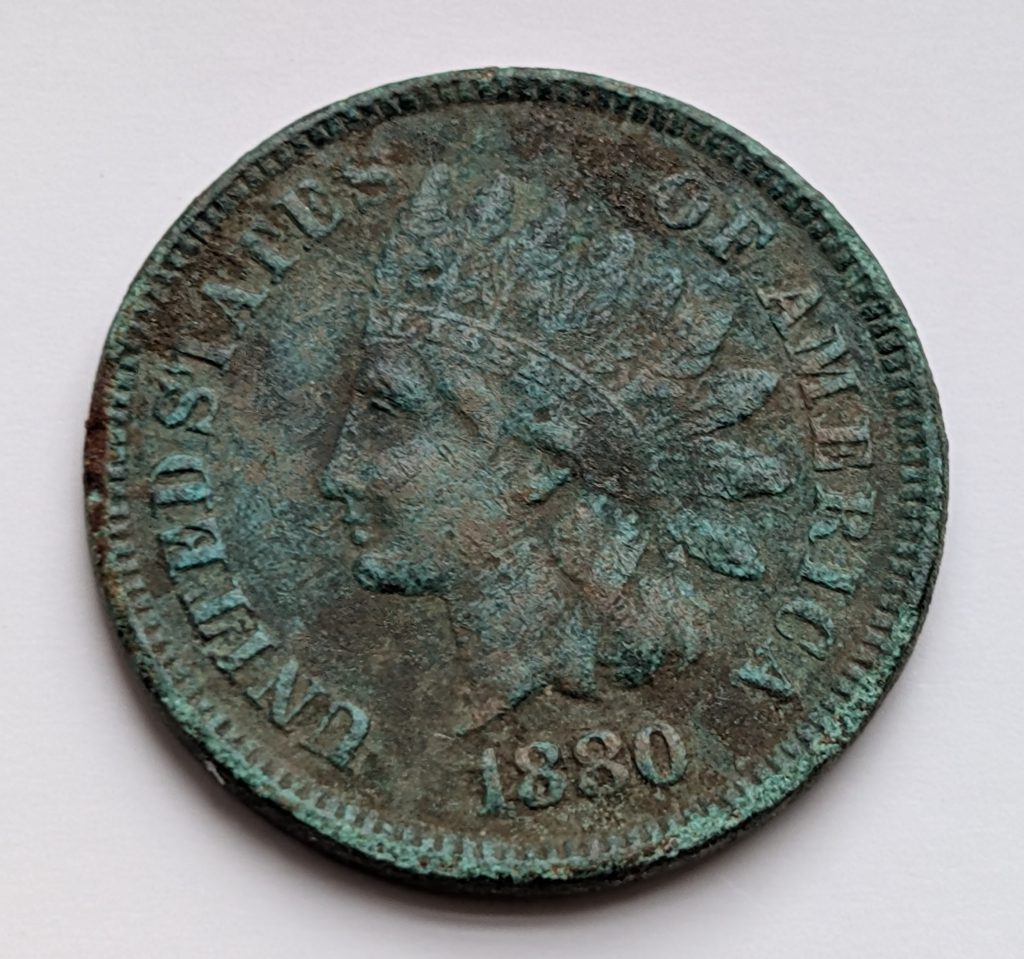Green, Black, and Crusty: What Different Colors of Corrosion Mean
Not all corrosion looks the same. Sometimes it’s a faint green haze creeping along the edges. Other times it’s a thick, black crust that seems to rise up out of the metal itself. Each color tells a different story, about what the coin has been through, what environment it’s been exposed to, and what kind of metal is breaking down underneath.
In this post, we’ll break down what the different colors of corrosion mean, how they form, and what they might say about the coin’s condition or salvageability.
Green Corrosion

This 1880 Indian Head Cent is covered in active green corrosion, especially around the devices and rim. The buildup has softened the details and indicates long-term environmental exposure.
Green corrosion is the most common form you’ll see on copper-based coins like Indian Head cents, large cents, and some older nickels. It’s usually a result of oxidized copper compounds like copper carbonate, chloride, or acetate. Think of it like the Statue of Liberty’s patina, but on a much smaller, uglier, and more damaging scale.
It can show up as:
- A thin film over the coin’s surface
- Spotty patches that eat into the detail
- Fuzzy buildups that signal active decay
This type of corrosion is often referred to as “bronze disease” when it’s aggressive, and if it’s active, it’ll keep spreading unless properly treated. Even in mild cases, the green can mask fine details and wreck the eye appeal, which kills collector value fast.
If the color is more pastel or powdery green, it’s probably dry and stable. If it looks slick, vibrant, or seems to be growing and that’s a problem.
Black Corrosion
Black corrosion usually shows up when a coin has been exposed to long-term moisture, pollution, or sulfur-rich environments, especially in urban soil or old basements. On copper coins, this corrosion appears as flat, dark spots or large blotches that dull the surface and obscure detail. On silver, it may show up as hardened, uneven black crust that almost looks burned into the coin.
Unlike green corrosion, which can sometimes flake off in layers, black corrosion tends to be more deeply fused to the metal. It may not look dramatic at first glance, but it often means serious metal loss has already occurred underneath.
If a coin has black spots that won’t shift under magnification or show texture differences from the surrounding surfaces, it’s likely not toning, it’s damage. And once it’s black, there’s rarely any going back.
Crusty Corrosion
This is the kind of corrosion that makes a coin look like it was buried under a barn for a century, because sometimes it was. Crusty corrosion is rough, brittle, and uneven. It can form raised lumps, flaky patches, or barnacle-like growths that seem glued to the coin’s surface.
It’s usually a mix of environmental factors: moisture, dirt, fertilizers, chemicals, and time. This type of damage often builds in layers, and trying to remove it without proper conservation will usually strip off the underlying detail too.
If a coin feels like sandpaper when you run a (gloved) finger across it, or flakes visibly under a scope, you’re looking at corrosion that’s already eaten into the metal. Crust like this almost always signals permanent damage. It’s also a clear red flag for buyers, which makes it easier to spot and avoid.
Final Thoughts
Understanding corrosion isn’t just about spotting damage, it’s about learning what your coin has been through and making smart decisions going forward. Whether it’s a green haze, black crust, or that classic copper crumble, each form tells a story.
Most importantly, knowing what you’re seeing helps you avoid throwing money at something that’s too far gone, or worse, mistaking damage for value. And if you’re buying, selling, or just trying to protect what you’ve got, recognizing these signs early will save you time, money, and headaches.
Next up: we’re taking a closer look at the dramatic damage caused by shipwrecks and saltwater. Spoiler alert… it’s not treasure.
